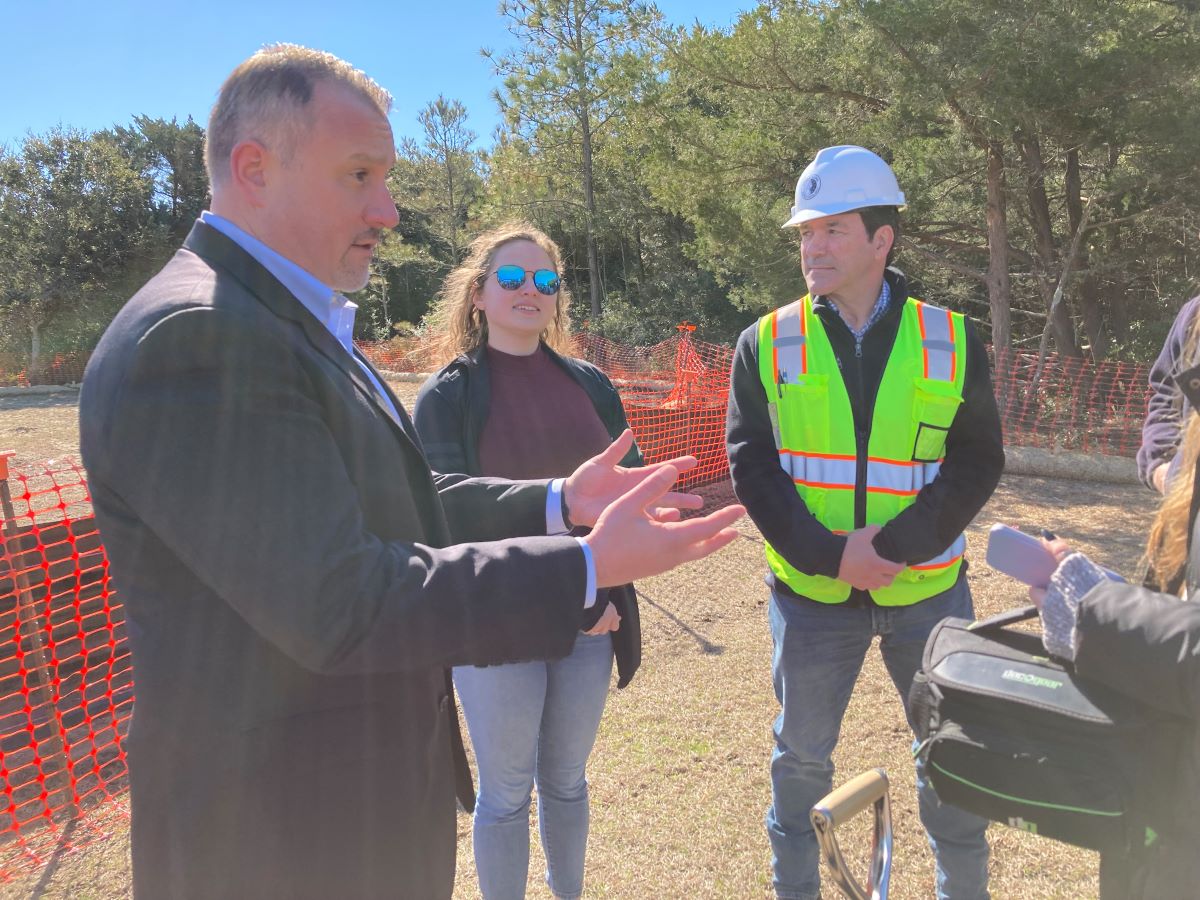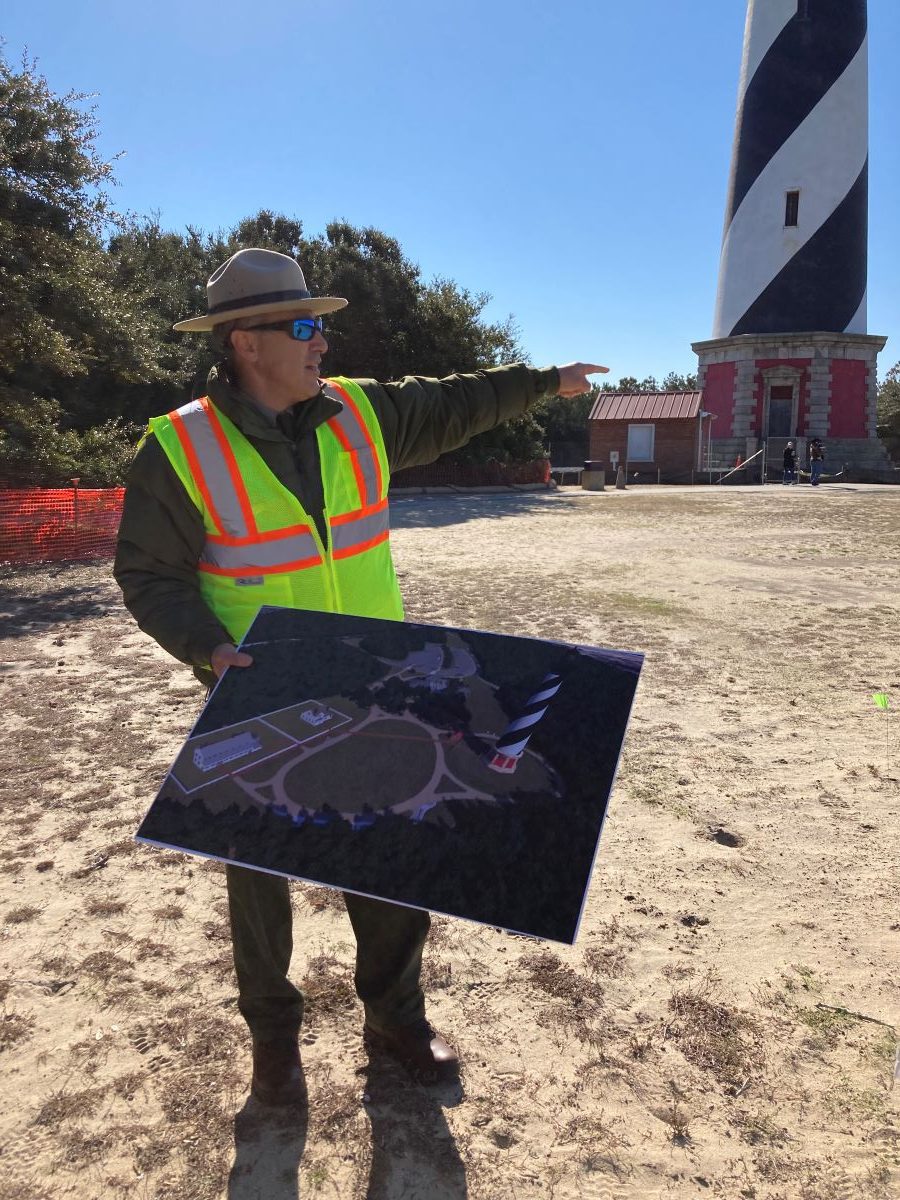
BUXTON — Scaffolding soon will completely encircle the swirling black and white bands of the Cape Hatteras Lighthouse as contractors start construction of the first comprehensive project to restore the 1870 tower inside and out, top to bottom, including numerous historic features lost to time.
Replicas of the Victorian-style iron fence that once circled the tower’s base, and the majestic first-order Fresnel lens that once filled the lantern room at its top, will be crafted with historic accuracy to replace the long-gone originals.
Supporter Spotlight
“We do projects up and down the East Coast,” Christopher Dabek, vice president of North Brookfield, Massachusetts-based contractor Stone & Lime Masonry Restoration Services Inc. told a small group of media Feb. 14 during a groundbreaking ceremony. “But I think this is the most iconic.”
The $19.2 million contract includes new paint, replacement or repair of cast iron, mortar, granite, metal and concrete, as well as replacement of an estimated 40,000 bricks, about 15% of the 1.25 million bricks used to build the beacon.
“Everything here is going to be custom made, the cast iron, the bricks,” Dabek said, adding that parts of the granite foundation and marble tile floors also will be rehabilitated with materials close as possible to the original.
In addition to the structural repairs of the beacon, the walking paths and landscaping leading into and around the light station will be updated to improve connectivity for visitors and prevent degradation of the landscape.
“Within these new pathways, the contoured landscape will be filled with native vegetation to encourage visitors to stay on the paths and promote resiliency of the grounds,” subcontractor VHB Engineering NC states on its website.
Supporter Spotlight
The 36 lighthouse foundation stones, which had been left behind on the beach until 2015, have been removed from their repurposed amphitheater arrangement, created to honor the light keepers, that had been outside the entrance.
Currently, the design plan calls for the lightkeeper stones to be relocated inside the grounds and placed in an alternating pattern along the pathway, Cape Hatteras National Seashore Superintendent Dave Hallac told the media. The concrete path, he added, will be the color of sand to blend with the surrounding landscape, winding from the parking lot past the two light keeper buildings and around the lighthouse, with interpretive signage along the way.
“This is really going to facilitate that visit and that experience,” Hallac said.
Although the bookstore and portions of the grounds at the light station will remain open during the day, he said, the lighthouse will remain closed for the extent of the 18-month project.
“It’ll be worth it,” Hallac affirmed.

Looking up at the 4,830-ton tower, the tallest brick lighthouse in the nation, it’s hard to believe that 25 years earlier, different contractors were preparing to move the lighthouse, which began its roll 2,900 feet southwest on June 17, 1999, away from the encroaching surf threatening its foundation.
Pegged as “the move of the century,” the slow-motion relocation ended 23 days later, successfully landing the lighthouse at its current location.
Simply put, the project, which had begun earlier that year with the less-involved relocation of the light station’s two keepers quarters buildings and other infrastructure, involved the tower being separated from and lifted off its foundation, placing it on rails, hooking it up to special sensors and moving it hydraulically, inch-by-inch along steel mats placed ahead on the pathway before installing it on the new foundation.
The project cost $12 million.
Contractor International Chimney Corp. of Buffalo, New York, assisted most prominently by subcontractor Expert House Movers of Maryland, were treated like celebrities by national and international media, and in turn charmed hordes of visitors who crowded behind temporary fences to watch the spectacle.
John Havel, who retired from the Environmental Protection Agency, now owns Havel Research Associates in Salvo and is a board member with Outer Banks Lighthouse Society, has been researching the Cape Hatteras Lighthouse as a volunteer for many years. For that reason, besides his respect for the “amazing monument” to America, Havel is pleased that the project restores four important “character defining features” of the extraordinary architecture of the 1870 lighthouse.
“This is the first restoration in 154 years that they’ve ever had, top to bottom,” he said in a recent phone interview. “I could go on and talk about many repair projects and smaller things they’ve had over the years but there’s never been anything this large.”
Restoration of the features that most people didn’t even know were gone adds immeasurable value to the historic integrity of the lighthouse, he believes. And they meaningly illustrate the architectural beauty and engineering skill of the era.
There were cast-iron pediments, ornamental Victorian elements, above the windows, which disappeared around 1964, Havel said. From about 1871 to 1920, there used to be the Victorian iron fence around the base, similar to the one that’s at the U.S. Treasury Building in Washington, D.C.
There used to be two sets of glass and wooden doors at different areas in the lighthouse that disappeared over the years, Havel said. And there used to be a 12-foot-tall, pineapple-shaped Fresnel lens, holding 1,000 seafoam-green glass prisms, sitting in the lantern room like a crown atop the Guardian of the Atlantic.
At least some of those character features were unearthed by Havel’s persistence in tracking down original documentation in government archives, and bringing his findings to the Park Service or the contractors.
Much to his delight, Havel said he also traced documents that determined that the checkerboard flooring, rather than made of linoleum or soapstone as described in at least one document, is instead made of Belgian black marble. The white tile is Carrera marble, which happens to be the same kind of marble from which Michelangelo carved the famous statue David.
“My slogan is that I have a secret weapon and this is very true and it is a secret weapon that nobody else has . . . . time,” he said. “I’ve been studying this lighthouse for 17 to 20 years. Nobody else has time to do that.”
Before the contractors start removing the interior and exterior paint — the method has not yet been nailed down, they said — the existing rotating airport light will be removed from the top, and a temporary beacon will be installed, leaving the sky dark in April and May, Hallac said.
The replica Fresnel lens is expected to be installed in the restored lighthouse in June to July 2025, again darkening the sky. Since the Hatteras light is still considered an aid to navigation, the Coast Guard will issue notices to mariners at the appropriate times to warn about the light being off.
Dan Spinella at Artworks Florida is doing the replica work. According to Havel, Spinella, who was unavailable for comment, has built and repaired more than 200 lenses for lighthouses and museums around the U.S.
Around 2009, he and another Fresnel lens expert, Jim Woodward, closely studied the remnants of the lighthouse’s original Fresnel lens, complete with 268 salvaged prisms, on loan by the Park Service for a display at the state Graveyard of the Atlantic Museum in Hatteras.
“He and Jim measured that, millimeter by millimeter,” Havel recalled, “and he built a perfect reproduction of that in his computer.”
Once the lighthouse reopens, with regular maintenance, it will be good for another century or so without needing another major project to save it.
“The restoration of the lighthouse and its grounds presents an excellent chance to educate future generations of visitors,” wrote Stephen Talley, Landscape Architect and Project Manager at VHB in its website article. “By improving the flow of pedestrians and increasing resiliency of the grounds and Lighthouse, this landmark will be able to withstand heavy visitation and frequent storms for another century.”







